 Facebook
Facebook
 X
X
 Instagram
Instagram
 TikTok
TikTok
 Youtube
Youtube
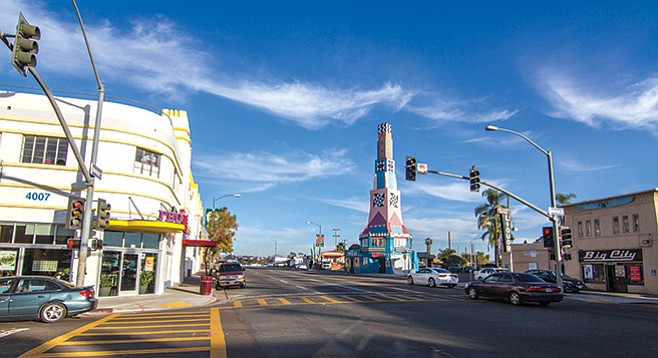
The large picture windows at Lotus Garden Seafood and Noodles restaurant in City Heights overlook the corner of Euclid and University. Over a heaping plate of chicken chow fun, one can observe the comings and goings of Hispanic, East African, Asian, African-American, and Caucasian pedestrians, as well as teenagers of indeterminate race risking their lives crossing the street against the light on skateboards.

Cars, buses, and fire trucks fly past the tower that gives a name to the Tower Bar across the street. The whole atmosphere is urban, eclectic, and alive in a way unlike any other neighborhood in San Diego.
City Heights has a population density of 17,900 people per square mile, says citydata.com; 40.7 percent are foreign-born residents and 18.8 percent of City Heights residents speak English not well or not at all.
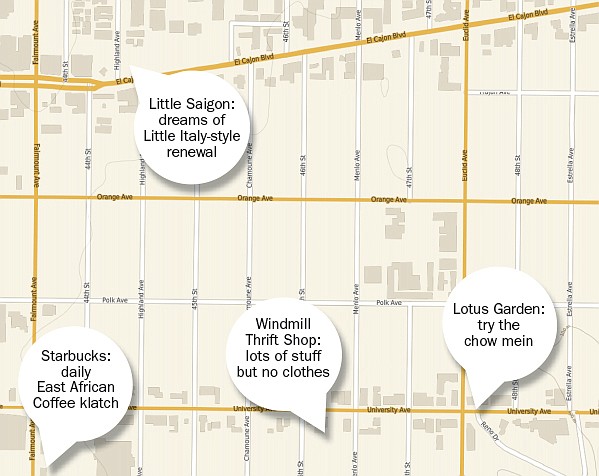
For perspective, greater San Diego has a population density of 4301 people per square mile, 26.8 percent foreign-born residents, and 8.1 percent of residents who speak English not well or not at all.
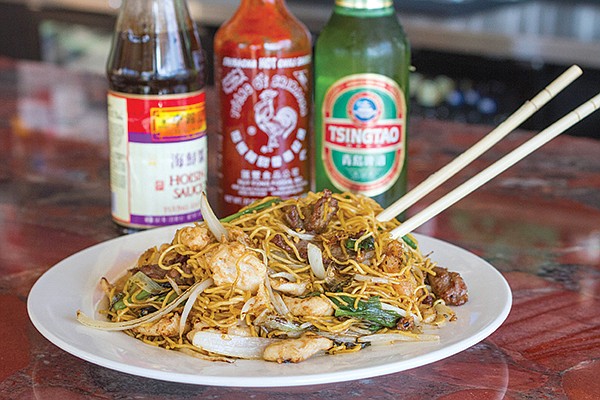
Eric Hoeun, a 20-year-old waiter at Lotus Garden, has lived in the neighborhood all his life and says the diversity is the best thing about City Heights. “There are so many ethnicities around here, and just seeing everybody live their life here, to me, is a beautiful sight,” he says.
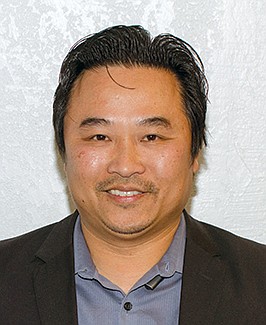
This seems to be a popular opinion in the neighborhood, but so far the number of languages spoken and the variety of food available hasn’t been enough of a draw to make City Heights the North Park–like destination for which some homeowners have been hoping. To get an idea of why that might be, I spend a coolish Friday afternoon in early November wandering up and down University and El Cajon asking residents and visitors what they love about City Heights, what they’d like to improve, and what they think might be different in ten years.
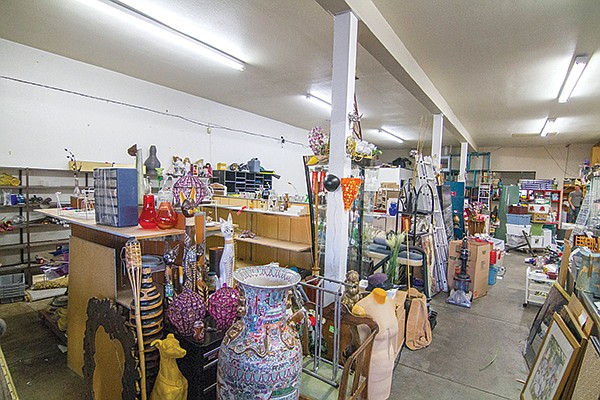
Elidia (no last name provided) is one of the first people I meet. I catch her waiting for the number 10 bus at a stop on the south side of University, across the street and a few steps west of Lotus Garden. The 33-year-old security guard has lived in City Heights for 20 years and is on her way to work at the SDSU basketball game against San Diego Christian College.
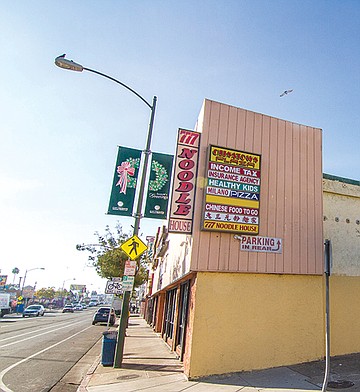
Elidia wears a red shirt and smells of fresh hair pomade. The first thing she says when I ask what she likes about her neighborhood is, “The variety of cultures around here.” And then she adds, “And basically the food.” She gestures across to a squat building housing a row of storefronts including Chinatown Plaza Chinese fast food, 5 Star Pizza, and 777 Noodle House.
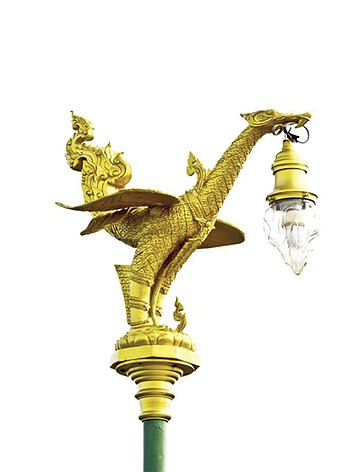
As for what she would like to see improve in City Heights, Elidia says, “The violence. The shooting that happens between two and three in the morning.” She acknowledges that things have changed in the past decade or so, saying, “There’s more patrolling of officers, and gangs have minimized a lot.” But it’s not quite enough, as far as she’s concerned.

“A week ago, there was a shooting, and there were more officers outside because of that,” she says. “But they should always be outside, no matter what.”
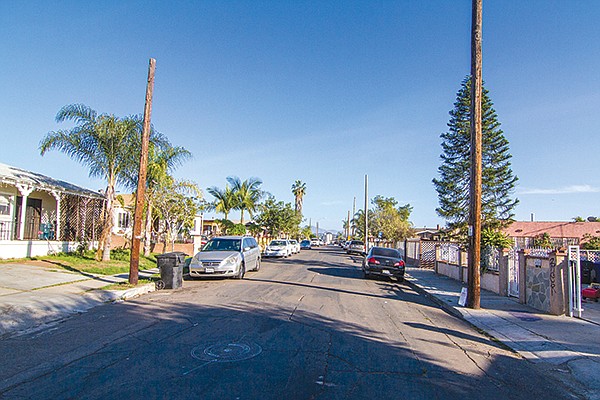
Elidia’s bus arrives and brings our conversation to an end, but later, a quick internet search for “shooting City Heights San Diego” yields news stories from shootings on October 5, November 8, November 26, and April 3, all on the first page.
A San Diego Association of Governments crime report for January 2017 through September 2017, on the other hand, shows both Teralta/City Heights East and Teralta/City Heights West as significantly lower in both violent crime and property crime than Pacific Beach, North Park, Hillcrest, Gaslamp, and East Village.
After Elidia’s bus leaves, I make my way west on University past Pronto Laundry (whose signage promises, “Cooler inside! New AC),” past Cricket wireless, Uni Tire, and University Smog. Just as I’m approaching the door to the Windmill Thrift Store, a postal worker steps out. Her name is Cathy Nelson. She’s 31 and happy to chat. Nelson’s bright smile won’t waver for the full ten minutes that we stand talking in front of the thrift store.
“I like it. Minus how dirty it is,” she says of City Heights. “It’s always an upbeat neighborhood. You do see a lot of mental health here, though. Like, a lot of homeless people. People who aren’t…all there.”
Nelson moved to San Diego from Arizona eight years ago and since then has worked routes in Normal Heights, La Mesa, and National City. Currently, she’s a resident of North Park and has been delivering mail to this part of City Heights since January 2017.
“You just meet so many different kinds of people. Everybody is from different cultures,” she says. “I love all the small businesses, too.”
As far as food goes, Nelson is partial to the tacos at Mucha Fruta, a few blocks east on University, in a building shared by Tu Thanh, a Vietnamese restaurant. Otherwise, she can’t recommend much in the neighborhood as far as what to do or see because she doesn’t spend time here outside of work. When I ask what she would like to see here, or what might draw her to spend some of her time off in City Heights, she pauses for a moment, laughs to herself, and then says, “A brewery. I’m just waiting for the gentrification,” she says. “You can see it coming from North Park. You see how much some of the houses sell for, and how much they’re investing.”
Nelson hopes the neighborhood doesn’t change too much and lose its flavor, though. She fears that could happen if rents go up too much and drive out the diverse community that resides here now. “There’s a lot of owners who live in these apartments and are, like, ‘We’ve owned this building for 50 years,’ so hopefully they’ll stay strong.”
Would she live here?
“Yes,” she says. “Depends on which street, though.”
Aside from a small rack by the door and a beaded dress draped over a mannequin in what appears to be the dish section, Windmill Thrift Store offers very few items of clothing. Instead of clothes, the place is stuffed with items such as a four-foot statue of a seated doberman painted a bright, garish yellow; a duffle bag jam-packed with raggedy Barbie dolls and VHS movies; dishes, vases, dressers, and a heavy metal rhino head wall-hanging. One could spend hours picking and poking and marveling at all the stuff available for purchase here. At the moment, there is a handful of shoppers, but they’re quiet, discreet, and hard to spot among all the shelves and things piled at various angles throughout the store.
I find Chris Anderson browsing the merchandise. His youthful bearded face and khaki shorts set him apart from the working-class vibe of the neighborhood, and I make the quick assumption that he is among the newest wave of gentrifiers who are beginning to purchase homes and settle into the neighborhood. Turns out I’m wrong.
Anderson, 30, has just gotten off a bus from Hillcrest, where he had lunch, and has come to City Heights for some thrift shopping. He’s starting here at Windmill and then will head over to the UCP thrift store on El Cajon.
“This is an awesome thrift store,” he says. “There are just so many odd things, and almost no clothes. Look at the dresser and the antiques and stuff.”
A resident of “near Kensington,” Anderson found this thrift shop during his days as an employee of an ambulance company in La Mesa when they would drive up and down University Avenue. The two neighborhood thrift shops he frequents are his only connection to City Heights. When I ask what else he knows about the area, he pauses and says, “I’m trying to think of a way to say this that’s not rude.”
After a moment, he says, “The only thing I know about City Heights is that it’s a cheaper neighborhood to live. We purchased our place recently so I’ve seen the real estate costs out here. What I understand is that it has to do with the crime rates. I don’t know if that’s true or not, but…”
He trails off, examining a straw hat that looks about five sizes too small for him. After placing it on top of his head briefly and then putting it back down, he goes on to explain that although he and his wife did look at real estate values in City Heights, they never actually considered purchasing in this area. To the question of why not, he says, “We were used to living in Hillcrest, so living out here would be weird. Where we are, we’re close to Adams, near Kensington, which is kind of a trendy neighborhood.”
Still, he does admit that he sees some of that trendiness heading this way and he believes that it will positively impact home prices. He speculates that if someone had purchased a home in this area two years ago (“Now isn’t a great time to buy”) it would probably be worth double what they paid for it in 10 or 15 years.
But he and his wife chose not to do that. “You’d have to commit 10 or 15 years of living in an area you don’t want to be in,” he says. And then, as if finally deciding to say it plain, he adds, “Kensington is just a nicer neighborhood.”
Two months from now, the storefront will be empty, with bars covering the windows and a sign on the glass door that reads, “The Windmill Thrift Store is moving. We will be closing the store on Wednesday 1/17/2018. For information on new location, please call (619-952-1593).”
Many Starbucks I’ve happened into have had a sort of community-center vibe. The Starbucks on Fairmount in City Heights takes that whole community-gathering-place thing to a new level. The diversity of the patrons at this particular Starbucks may be due to its proximity to the public library, the rec center, the farmers’ market, and the Mid-City campus of the San Diego Continuing Education building. Of course, the exact makeup of the crowd at Starbucks changes hourly, but one thing that is pretty much guaranteed is that there is always a group of African men shooting the breeze beneath the green canopies on the patio. It’s here that I meet Ambrose Ulau, a 42-year-old South Sudanese father of five.
On this Friday afternoon as I approach the parking lot, a handful of men stand up from a loose grouping of about ten chairs around two square tables. They shout back and forth to each other as the group disbands, each heading out in a different direction. Only two men are still seated by the time I arrive. Ulau is one of them. The other stands up and walks away when I sit down.
Ulau, a custodian at UCSD, has been coming to this Starbucks since 2006 to have coffee with cream and sugar and to hang out and chat with the other men who gather here daily. He tells me there’s no big secret to their meetings, no structure, no formal group. It’s an informal gathering that’s been happening here at the City Heights Starbucks for as long as he’s been around. And he’s not exactly sure when it started.
“It changes all the time,” he says. “They’re all people from different countries. Somalian, Sudanese, South Sudanese, Ethiopian. I’ve met them all here. People come here just to talk. I come here sometimes, but not every day.”
Besides coming to hang out at Starbucks, Ulau doesn’t do much else in City Heights. He lives here with his wife and five children, but they don’t go out to restaurants or anything. They cook and eat at home. On Sundays and during special-occasion events, they also spend time at St. Luke’s Episcopal Church in North Park.
Though he did hear that City Heights used to be “a bad area,” Ulau has only good things to say about the neighborhood now.
“It’s a nice place. There’s cool people. Nothing bad here,” he says.
Richard Matuska, 54, pretty much agrees with Ulau. “It’s just real peaceful here,” he says, scooting out from beneath the old blue Camaro in his garage. His hands are smeared with grease from the work of installing a new engine and transmission, so he offers me an elbow and a forearm instead of a handshake. “I can’t really find anything bad to say about the place.”
Matuska leads me to the side of the house, where we sit in two blue chairs on a concrete porch that looks out over a quiet residential enclave off of Euclid. For 20 minutes or so, we talk and watch the comings and goings of the neighborhood, which pretty much consist of a mail truck and single car heading up the hill from where the street dead-ends about a block down. It’s hard to believe this sleepy junction sits less than half a mile from the crazy-busy intersection at Euclid and University.
Matuska bought this three-bed, two-bath house in 2002 for $156,000. Now, 16 years later, after he added a two-car garage and redid the windows, roof, electrical, plumbing, cabinets, counters, and floors, he estimates his house value is close to the $500,000 his neighbor is asking for a three-bed, three-bath house.
Even with all the changes he’s made to his home, the current estimated value (just south of $450,000, according to both Trulia and Zillow) points to a general increase in home values in the neighborhood. Zillow currently lists the area’s median sale price for a three-bedroom, single-family home around $430,000, up from $230,000 at the end of 2011.
Matuska loves the neighborhood for its “proximity to everything” as well as the peaceful nature of his little corner of it, but he’s also hoping to see more significant changes in the neighborhood at large.
“It’s not turning into North Park as fast as we would like,” he says. “I’d like to see it continue to improve as far as the businesses along University. Whenever you see an area start to boom, you get a lot of restaurants and shopping in those areas. It’s a destination, and people want to go there.”
He mentions the $1.4 million renovation of the Silverado Ballroom at the corner of Euclid and University as evidence that change is coming this way, and he counts Lotus Garden as one of the few City Heights businesses that he patronizes. But besides a couple of neighborhood establishments owned by a neighbor friend, Matuska does most of his shopping, dining out, and socializing in other parts of San Diego. When I ask where in the neighborhood he might take a visitor from out of town, he says, “Typically, when people come here, they want to see the beach, so you don’t spend a lot of time in City Heights.”
But he hopes this will change. “They changed the area on El Cajon to Little Saigon and they keep saying it will be like Little Italy,” he says. “Little Italy is incredible, but I don’t see that happening quite yet.”
If Su Nguyen has his way, City Heights will be the next Little Italy within ten years. On a balmy November evening a week or so later, I meet Nguyen at that time of day when palm trees stand black against the fire-colored sunset and traffic on El Cajon streams steadily in both directions. Nguyen, chairman of the board and cofounder of the Little Saigon Foundation, leads me to a conference room on the second floor of 4444 El Cajon and shows me the ten-year-plan for the more that’s coming to City Heights. On the east wall hang 20 glossy pages, complete with pictures, maps, and written text outlining the proposed details of the Little Saigon San Diego Open Air Museum.
The proposed museum consists of 20 “stops” along the El Cajon corridor between Euclid and Highland. The first stop, the Vietnamese Heritage Flag, will stand a block or so west of Highland, officially outside the boundaries of Little Saigon, as it’s the only location that meets the safety requirements of the city’s Department of Safety. The 65-foot-tall flag will be visible as far as two miles away. This part of the project is underway, and completion is expected in April 2018.
Other project details include 12 light poles bearing the mythical Chim Lac (a guardian-angel–type creature) at major intersections, a golden dragon in the median between 45th and Chamoune Streets, a night market at Hoover High School, parklets, bamboo-hut bus stops, and urban street murals. Many of the details are meant to celebrate the area’s Vietnamese residents and their culture, but Nguyen emphasizes that some of them are also meant to acknowledge the broader immigrant population of City Heights.
“City Heights is the home of refugees in San Diego County,” he says, pointing to Stop 14 – Yearning for Freedom, a piece of sculptural art proposed for an area in front of the A-Chau Restaurant between 46th and Menlo. “Yearning for freedom. We’re all here in City Heights for that, the community. Somalian, Cambodian, Lao — we are all refugees. Not only Vietnamese.”
In addition to revitalizing the area officially designated (in 2013) as Little Saigon Cultural and Commercial District and bringing more visitors to City Heights, Nguyen hopes that the Little Saigon project will help inspire community involvement and increase the voting power of area residents.
“Most of the time when so many different groups are together, we tend to be closed off and stay within our own group, our own community. We don’t see civic engagement as a whole. That’s not good,” he says. “We don’t want somebody else deciding for City Heights. We want City Heights people to decide.”
Some of the major improvements that he’d like to see have to do with infrastructure and safety, such as better lighting and more walkable sidewalks. But many of the project details, such as the parklets and art installations, will also address what he sees as the need for public open spaces and create a destination atmosphere that the El Cajon corridor east of the 15 currently does not have.
“Besides Little Italy, we don’t have any other Little. But now we have Little Saigon,” Nguyen says. “Fortunately, we live next to well-off communities: Kensington, Talmadge, and recently Hillcrest, and North Park. We’re the neighbor, so why not City Heights, too?”
Aside from a two-year stint living in Encanto, Nguyen has lived in City Heights since he arrived in San Diego in 1993, and he loves the neighborhood for its diversity and proximity to downtown, Balboa Park, and San Diego State University. In his 24 years here, he says he has seen a lot of changes in the area but that there’s always room for improvement.
“Price Charities is doing a very good job,” he says. “There’s new affordable housing, and I see less crime than before in the last ten years.” Here he pauses and smiles, letting out a little laugh before continuing, “But we want more.”
Up on the wall, the proposed changes look shiny and enticing, but at street level, they’re a little harder to imagine. At 3:00 on a sunny afternoon in early December, I stand at the corner of Highland and El Cajon, squinting at the stream of students pouring out of Hoover High and across the street toward me. I try to envision them streaming across a median where a golden dragon lives in a bed of flowers to get to the KFC, but it’s difficult.
When I spy Carlos Ramirez and Vincent Viola standing still within the throng of moving students, I decide to ask what they think of the project. Actually, only Ramirez is standing. Viola sits in a golf cart. They both have the relaxed manner of men whose hardest part of the day is over. I mistake them both for security, and I won’t know until the end of our conversation that while Viola is security, Ramirez is finishing up his last day as a vice principal before he moves on to a district job. At that point, Ramirez will make it clear that he speaks as a member of the larger community, not as a vice principal.
The funny thing is that although we could all reach out and touch the building where Nguyen’s glossy pages hang on the wall, and although both men work right here in the middle of Little Saigon, neither of them know anything about the night market, the golden dragon, the parklets, or any of the rest of the ten-year-plan. But they’re intrigued and think it will be great for the neighborhood.
“I think anytime there are improvements to the physical environment, it helps to get a different perception of where we are. Look at the sidewalks,” Ramirez says. “Look at our streets. One street I drive through near Euclid Avenue, the pavement has been ignored for years. Unfortunately, this is an area that has been forgotten.”
Viola nods his head and chimes in the moment Ramirez takes a breath. “A lot of problems in the area are due to voting,” he says. “There are 346,000 voters in this area, and less than 20 percent vote on all of the local issues.”
A kid rides by on a skateboard and slows down long enough to shake both men’s hands. He shakes mine, too, and then rides off. Another handful of kids wave and say good-bye as they head across El Cajon, trying to catch the light.
“One of the misconceptions about our community is that bad people live here,” Ramirez says. “Some of the most successful individuals that I know grew up here in City Heights.”
Ramirez grew up in the community, attended Hoover High, and wants the same for his children. Although he currently lives east of Euclid, which is outside the official boundaries of City Heights, he still feels an allegiance to the neighborhood.
Viola, not so much. He used to live in the area, but he moved to Normal Heights because, “[City Heights] sucks,” he says. “I wouldn’t want my wife or my daughter walking around here at night.” Nevertheless, Viola does like the neighborhood’s food offerings quite a bit. He had his whole Thanksgiving dinner catered by Saigon, the restaurant directly across the street.
Ramirez likes Vietnamese food okay, but he’s partial to Mexican. He likes to get lunch at El Panson, on the other side of Highland. Other options within a block of Hoover High include more Mexican, Italian, Vietnamese, Wienerschnizel, and KFC. And within a few blocks, one can find Ethiopian, Somali, Laotian, Thai, and Chinese.
The diversity of restaurant options has still not landed City Heights on any list of hottest neighborhoods in San Diego that this writer has seen. But maybe that depends on who’s being asked.


The large picture windows at Lotus Garden Seafood and Noodles restaurant in City Heights overlook the corner of Euclid and University. Over a heaping plate of chicken chow fun, one can observe the comings and goings of Hispanic, East African, Asian, African-American, and Caucasian pedestrians, as well as teenagers of indeterminate race risking their lives crossing the street against the light on skateboards.

Cars, buses, and fire trucks fly past the tower that gives a name to the Tower Bar across the street. The whole atmosphere is urban, eclectic, and alive in a way unlike any other neighborhood in San Diego.
City Heights has a population density of 17,900 people per square mile, says citydata.com; 40.7 percent are foreign-born residents and 18.8 percent of City Heights residents speak English not well or not at all.

For perspective, greater San Diego has a population density of 4301 people per square mile, 26.8 percent foreign-born residents, and 8.1 percent of residents who speak English not well or not at all.

Eric Hoeun, a 20-year-old waiter at Lotus Garden, has lived in the neighborhood all his life and says the diversity is the best thing about City Heights. “There are so many ethnicities around here, and just seeing everybody live their life here, to me, is a beautiful sight,” he says.

This seems to be a popular opinion in the neighborhood, but so far the number of languages spoken and the variety of food available hasn’t been enough of a draw to make City Heights the North Park–like destination for which some homeowners have been hoping. To get an idea of why that might be, I spend a coolish Friday afternoon in early November wandering up and down University and El Cajon asking residents and visitors what they love about City Heights, what they’d like to improve, and what they think might be different in ten years.

Elidia (no last name provided) is one of the first people I meet. I catch her waiting for the number 10 bus at a stop on the south side of University, across the street and a few steps west of Lotus Garden. The 33-year-old security guard has lived in City Heights for 20 years and is on her way to work at the SDSU basketball game against San Diego Christian College.

Elidia wears a red shirt and smells of fresh hair pomade. The first thing she says when I ask what she likes about her neighborhood is, “The variety of cultures around here.” And then she adds, “And basically the food.” She gestures across to a squat building housing a row of storefronts including Chinatown Plaza Chinese fast food, 5 Star Pizza, and 777 Noodle House.

As for what she would like to see improve in City Heights, Elidia says, “The violence. The shooting that happens between two and three in the morning.” She acknowledges that things have changed in the past decade or so, saying, “There’s more patrolling of officers, and gangs have minimized a lot.” But it’s not quite enough, as far as she’s concerned.

“A week ago, there was a shooting, and there were more officers outside because of that,” she says. “But they should always be outside, no matter what.”

Elidia’s bus arrives and brings our conversation to an end, but later, a quick internet search for “shooting City Heights San Diego” yields news stories from shootings on October 5, November 8, November 26, and April 3, all on the first page.
A San Diego Association of Governments crime report for January 2017 through September 2017, on the other hand, shows both Teralta/City Heights East and Teralta/City Heights West as significantly lower in both violent crime and property crime than Pacific Beach, North Park, Hillcrest, Gaslamp, and East Village.
After Elidia’s bus leaves, I make my way west on University past Pronto Laundry (whose signage promises, “Cooler inside! New AC),” past Cricket wireless, Uni Tire, and University Smog. Just as I’m approaching the door to the Windmill Thrift Store, a postal worker steps out. Her name is Cathy Nelson. She’s 31 and happy to chat. Nelson’s bright smile won’t waver for the full ten minutes that we stand talking in front of the thrift store.
“I like it. Minus how dirty it is,” she says of City Heights. “It’s always an upbeat neighborhood. You do see a lot of mental health here, though. Like, a lot of homeless people. People who aren’t…all there.”
Nelson moved to San Diego from Arizona eight years ago and since then has worked routes in Normal Heights, La Mesa, and National City. Currently, she’s a resident of North Park and has been delivering mail to this part of City Heights since January 2017.
“You just meet so many different kinds of people. Everybody is from different cultures,” she says. “I love all the small businesses, too.”
As far as food goes, Nelson is partial to the tacos at Mucha Fruta, a few blocks east on University, in a building shared by Tu Thanh, a Vietnamese restaurant. Otherwise, she can’t recommend much in the neighborhood as far as what to do or see because she doesn’t spend time here outside of work. When I ask what she would like to see here, or what might draw her to spend some of her time off in City Heights, she pauses for a moment, laughs to herself, and then says, “A brewery. I’m just waiting for the gentrification,” she says. “You can see it coming from North Park. You see how much some of the houses sell for, and how much they’re investing.”
Nelson hopes the neighborhood doesn’t change too much and lose its flavor, though. She fears that could happen if rents go up too much and drive out the diverse community that resides here now. “There’s a lot of owners who live in these apartments and are, like, ‘We’ve owned this building for 50 years,’ so hopefully they’ll stay strong.”
Would she live here?
“Yes,” she says. “Depends on which street, though.”
Aside from a small rack by the door and a beaded dress draped over a mannequin in what appears to be the dish section, Windmill Thrift Store offers very few items of clothing. Instead of clothes, the place is stuffed with items such as a four-foot statue of a seated doberman painted a bright, garish yellow; a duffle bag jam-packed with raggedy Barbie dolls and VHS movies; dishes, vases, dressers, and a heavy metal rhino head wall-hanging. One could spend hours picking and poking and marveling at all the stuff available for purchase here. At the moment, there is a handful of shoppers, but they’re quiet, discreet, and hard to spot among all the shelves and things piled at various angles throughout the store.
I find Chris Anderson browsing the merchandise. His youthful bearded face and khaki shorts set him apart from the working-class vibe of the neighborhood, and I make the quick assumption that he is among the newest wave of gentrifiers who are beginning to purchase homes and settle into the neighborhood. Turns out I’m wrong.
Anderson, 30, has just gotten off a bus from Hillcrest, where he had lunch, and has come to City Heights for some thrift shopping. He’s starting here at Windmill and then will head over to the UCP thrift store on El Cajon.
“This is an awesome thrift store,” he says. “There are just so many odd things, and almost no clothes. Look at the dresser and the antiques and stuff.”
A resident of “near Kensington,” Anderson found this thrift shop during his days as an employee of an ambulance company in La Mesa when they would drive up and down University Avenue. The two neighborhood thrift shops he frequents are his only connection to City Heights. When I ask what else he knows about the area, he pauses and says, “I’m trying to think of a way to say this that’s not rude.”
After a moment, he says, “The only thing I know about City Heights is that it’s a cheaper neighborhood to live. We purchased our place recently so I’ve seen the real estate costs out here. What I understand is that it has to do with the crime rates. I don’t know if that’s true or not, but…”
He trails off, examining a straw hat that looks about five sizes too small for him. After placing it on top of his head briefly and then putting it back down, he goes on to explain that although he and his wife did look at real estate values in City Heights, they never actually considered purchasing in this area. To the question of why not, he says, “We were used to living in Hillcrest, so living out here would be weird. Where we are, we’re close to Adams, near Kensington, which is kind of a trendy neighborhood.”
Still, he does admit that he sees some of that trendiness heading this way and he believes that it will positively impact home prices. He speculates that if someone had purchased a home in this area two years ago (“Now isn’t a great time to buy”) it would probably be worth double what they paid for it in 10 or 15 years.
But he and his wife chose not to do that. “You’d have to commit 10 or 15 years of living in an area you don’t want to be in,” he says. And then, as if finally deciding to say it plain, he adds, “Kensington is just a nicer neighborhood.”
Two months from now, the storefront will be empty, with bars covering the windows and a sign on the glass door that reads, “The Windmill Thrift Store is moving. We will be closing the store on Wednesday 1/17/2018. For information on new location, please call (619-952-1593).”
Many Starbucks I’ve happened into have had a sort of community-center vibe. The Starbucks on Fairmount in City Heights takes that whole community-gathering-place thing to a new level. The diversity of the patrons at this particular Starbucks may be due to its proximity to the public library, the rec center, the farmers’ market, and the Mid-City campus of the San Diego Continuing Education building. Of course, the exact makeup of the crowd at Starbucks changes hourly, but one thing that is pretty much guaranteed is that there is always a group of African men shooting the breeze beneath the green canopies on the patio. It’s here that I meet Ambrose Ulau, a 42-year-old South Sudanese father of five.
On this Friday afternoon as I approach the parking lot, a handful of men stand up from a loose grouping of about ten chairs around two square tables. They shout back and forth to each other as the group disbands, each heading out in a different direction. Only two men are still seated by the time I arrive. Ulau is one of them. The other stands up and walks away when I sit down.
Ulau, a custodian at UCSD, has been coming to this Starbucks since 2006 to have coffee with cream and sugar and to hang out and chat with the other men who gather here daily. He tells me there’s no big secret to their meetings, no structure, no formal group. It’s an informal gathering that’s been happening here at the City Heights Starbucks for as long as he’s been around. And he’s not exactly sure when it started.
“It changes all the time,” he says. “They’re all people from different countries. Somalian, Sudanese, South Sudanese, Ethiopian. I’ve met them all here. People come here just to talk. I come here sometimes, but not every day.”
Besides coming to hang out at Starbucks, Ulau doesn’t do much else in City Heights. He lives here with his wife and five children, but they don’t go out to restaurants or anything. They cook and eat at home. On Sundays and during special-occasion events, they also spend time at St. Luke’s Episcopal Church in North Park.
Though he did hear that City Heights used to be “a bad area,” Ulau has only good things to say about the neighborhood now.
“It’s a nice place. There’s cool people. Nothing bad here,” he says.
Richard Matuska, 54, pretty much agrees with Ulau. “It’s just real peaceful here,” he says, scooting out from beneath the old blue Camaro in his garage. His hands are smeared with grease from the work of installing a new engine and transmission, so he offers me an elbow and a forearm instead of a handshake. “I can’t really find anything bad to say about the place.”
Matuska leads me to the side of the house, where we sit in two blue chairs on a concrete porch that looks out over a quiet residential enclave off of Euclid. For 20 minutes or so, we talk and watch the comings and goings of the neighborhood, which pretty much consist of a mail truck and single car heading up the hill from where the street dead-ends about a block down. It’s hard to believe this sleepy junction sits less than half a mile from the crazy-busy intersection at Euclid and University.
Matuska bought this three-bed, two-bath house in 2002 for $156,000. Now, 16 years later, after he added a two-car garage and redid the windows, roof, electrical, plumbing, cabinets, counters, and floors, he estimates his house value is close to the $500,000 his neighbor is asking for a three-bed, three-bath house.
Even with all the changes he’s made to his home, the current estimated value (just south of $450,000, according to both Trulia and Zillow) points to a general increase in home values in the neighborhood. Zillow currently lists the area’s median sale price for a three-bedroom, single-family home around $430,000, up from $230,000 at the end of 2011.
Matuska loves the neighborhood for its “proximity to everything” as well as the peaceful nature of his little corner of it, but he’s also hoping to see more significant changes in the neighborhood at large.
“It’s not turning into North Park as fast as we would like,” he says. “I’d like to see it continue to improve as far as the businesses along University. Whenever you see an area start to boom, you get a lot of restaurants and shopping in those areas. It’s a destination, and people want to go there.”
He mentions the $1.4 million renovation of the Silverado Ballroom at the corner of Euclid and University as evidence that change is coming this way, and he counts Lotus Garden as one of the few City Heights businesses that he patronizes. But besides a couple of neighborhood establishments owned by a neighbor friend, Matuska does most of his shopping, dining out, and socializing in other parts of San Diego. When I ask where in the neighborhood he might take a visitor from out of town, he says, “Typically, when people come here, they want to see the beach, so you don’t spend a lot of time in City Heights.”
But he hopes this will change. “They changed the area on El Cajon to Little Saigon and they keep saying it will be like Little Italy,” he says. “Little Italy is incredible, but I don’t see that happening quite yet.”
If Su Nguyen has his way, City Heights will be the next Little Italy within ten years. On a balmy November evening a week or so later, I meet Nguyen at that time of day when palm trees stand black against the fire-colored sunset and traffic on El Cajon streams steadily in both directions. Nguyen, chairman of the board and cofounder of the Little Saigon Foundation, leads me to a conference room on the second floor of 4444 El Cajon and shows me the ten-year-plan for the more that’s coming to City Heights. On the east wall hang 20 glossy pages, complete with pictures, maps, and written text outlining the proposed details of the Little Saigon San Diego Open Air Museum.
The proposed museum consists of 20 “stops” along the El Cajon corridor between Euclid and Highland. The first stop, the Vietnamese Heritage Flag, will stand a block or so west of Highland, officially outside the boundaries of Little Saigon, as it’s the only location that meets the safety requirements of the city’s Department of Safety. The 65-foot-tall flag will be visible as far as two miles away. This part of the project is underway, and completion is expected in April 2018.
Other project details include 12 light poles bearing the mythical Chim Lac (a guardian-angel–type creature) at major intersections, a golden dragon in the median between 45th and Chamoune Streets, a night market at Hoover High School, parklets, bamboo-hut bus stops, and urban street murals. Many of the details are meant to celebrate the area’s Vietnamese residents and their culture, but Nguyen emphasizes that some of them are also meant to acknowledge the broader immigrant population of City Heights.
“City Heights is the home of refugees in San Diego County,” he says, pointing to Stop 14 – Yearning for Freedom, a piece of sculptural art proposed for an area in front of the A-Chau Restaurant between 46th and Menlo. “Yearning for freedom. We’re all here in City Heights for that, the community. Somalian, Cambodian, Lao — we are all refugees. Not only Vietnamese.”
In addition to revitalizing the area officially designated (in 2013) as Little Saigon Cultural and Commercial District and bringing more visitors to City Heights, Nguyen hopes that the Little Saigon project will help inspire community involvement and increase the voting power of area residents.
“Most of the time when so many different groups are together, we tend to be closed off and stay within our own group, our own community. We don’t see civic engagement as a whole. That’s not good,” he says. “We don’t want somebody else deciding for City Heights. We want City Heights people to decide.”
Some of the major improvements that he’d like to see have to do with infrastructure and safety, such as better lighting and more walkable sidewalks. But many of the project details, such as the parklets and art installations, will also address what he sees as the need for public open spaces and create a destination atmosphere that the El Cajon corridor east of the 15 currently does not have.
“Besides Little Italy, we don’t have any other Little. But now we have Little Saigon,” Nguyen says. “Fortunately, we live next to well-off communities: Kensington, Talmadge, and recently Hillcrest, and North Park. We’re the neighbor, so why not City Heights, too?”
Aside from a two-year stint living in Encanto, Nguyen has lived in City Heights since he arrived in San Diego in 1993, and he loves the neighborhood for its diversity and proximity to downtown, Balboa Park, and San Diego State University. In his 24 years here, he says he has seen a lot of changes in the area but that there’s always room for improvement.
“Price Charities is doing a very good job,” he says. “There’s new affordable housing, and I see less crime than before in the last ten years.” Here he pauses and smiles, letting out a little laugh before continuing, “But we want more.”
Up on the wall, the proposed changes look shiny and enticing, but at street level, they’re a little harder to imagine. At 3:00 on a sunny afternoon in early December, I stand at the corner of Highland and El Cajon, squinting at the stream of students pouring out of Hoover High and across the street toward me. I try to envision them streaming across a median where a golden dragon lives in a bed of flowers to get to the KFC, but it’s difficult.
When I spy Carlos Ramirez and Vincent Viola standing still within the throng of moving students, I decide to ask what they think of the project. Actually, only Ramirez is standing. Viola sits in a golf cart. They both have the relaxed manner of men whose hardest part of the day is over. I mistake them both for security, and I won’t know until the end of our conversation that while Viola is security, Ramirez is finishing up his last day as a vice principal before he moves on to a district job. At that point, Ramirez will make it clear that he speaks as a member of the larger community, not as a vice principal.
The funny thing is that although we could all reach out and touch the building where Nguyen’s glossy pages hang on the wall, and although both men work right here in the middle of Little Saigon, neither of them know anything about the night market, the golden dragon, the parklets, or any of the rest of the ten-year-plan. But they’re intrigued and think it will be great for the neighborhood.
“I think anytime there are improvements to the physical environment, it helps to get a different perception of where we are. Look at the sidewalks,” Ramirez says. “Look at our streets. One street I drive through near Euclid Avenue, the pavement has been ignored for years. Unfortunately, this is an area that has been forgotten.”
Viola nods his head and chimes in the moment Ramirez takes a breath. “A lot of problems in the area are due to voting,” he says. “There are 346,000 voters in this area, and less than 20 percent vote on all of the local issues.”
A kid rides by on a skateboard and slows down long enough to shake both men’s hands. He shakes mine, too, and then rides off. Another handful of kids wave and say good-bye as they head across El Cajon, trying to catch the light.
“One of the misconceptions about our community is that bad people live here,” Ramirez says. “Some of the most successful individuals that I know grew up here in City Heights.”
Ramirez grew up in the community, attended Hoover High, and wants the same for his children. Although he currently lives east of Euclid, which is outside the official boundaries of City Heights, he still feels an allegiance to the neighborhood.
Viola, not so much. He used to live in the area, but he moved to Normal Heights because, “[City Heights] sucks,” he says. “I wouldn’t want my wife or my daughter walking around here at night.” Nevertheless, Viola does like the neighborhood’s food offerings quite a bit. He had his whole Thanksgiving dinner catered by Saigon, the restaurant directly across the street.
Ramirez likes Vietnamese food okay, but he’s partial to Mexican. He likes to get lunch at El Panson, on the other side of Highland. Other options within a block of Hoover High include more Mexican, Italian, Vietnamese, Wienerschnizel, and KFC. And within a few blocks, one can find Ethiopian, Somali, Laotian, Thai, and Chinese.
The diversity of restaurant options has still not landed City Heights on any list of hottest neighborhoods in San Diego that this writer has seen. But maybe that depends on who’s being asked.
Comments